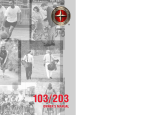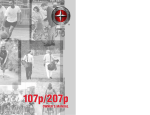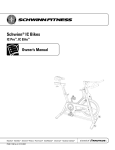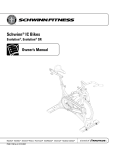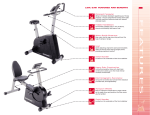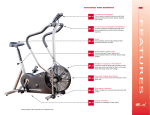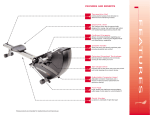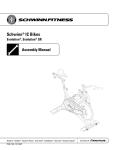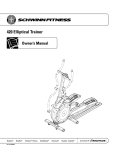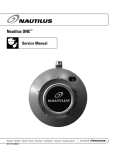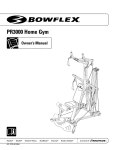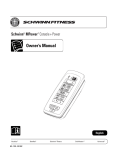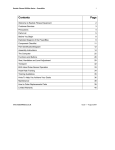Download Aerobics ProElite Owner`s manual
Transcript
® *IC Elite model shown IC ELITE BIKE FEATURES AND BENEFITS Seat Adjustment Anatomically designed seat adjusts for height and fore/aft position with locking pop pins. Adjustments accommodate various body types and allow for workout of different muscle groups. Position numbering is provided, to document your preferred position. Multi-position Handlebars Specially designed for in and out-of-the-saddle riding. The textured gripping surface provides a variety of hand and arm position for comfort and stability. Features a locking pop pin for height adjustments. Position numbering is provided, to document your preferred position. Pedal Resistance Control Knob & Emergency Brake Turning knob increases or decreases resistance on the flywheel. Pressing down on the emergency brake will stop the flywheel and pedal rotation. Perimeter Weighted Flywheel Concentrated mass on the outer edge combined with large gear ratio creates high inertia that best replicates the real world cycling experience. Schwinn Smart Release® System (IC Elite model only) Patented design offers all the benefits of a fixed gear, essential to any indoor cycling workout, while adding a unique “coasting feature”. Zinc Plated Frame Heavy gauge, commercial grade steel frame construction. Frame is completely zinc plated prior to application of powder coat finish for maximum corrosion resistance. Stainless steel fasteners throughout also resist corrosion. Stainless Steel Step Plate Convenient stainless steel plate provides step through platform and protects frame from scratches. Stainless Steel Pop-Pin Positive-lock pop pins are constructed from corrosion resistant stainless steel with plastic T-handles. Pip pins can be quickly threaded tight for a secure hold on the sliding tubes. Position Numbering Numbers are permanently stamped into the stainless steel material allowing the user to easily replicate their most comfortable riding position. CONGRATULATIONS! Thank you for making the Schwinn IC Bike a part of your exercise and fitness activities. For years to come, you’ll be able to rely on Schwinn craftsmanship and durability as you pursue your personal fitness goals. The Schwinn IC Bike is designed to closely simulate the feel and aerobic qualities of road cycling without the associated distractions. Its unique design, with fixed gearing and a high-inertia flywheel, produces a smooth, intense workout. By combining true road-racing geometry with high quality cycling componentry, you can cycle at far higher RPMs (revolutions per minute). Cycling at higher cadences and at varying resistance levels develops cardiovascular fitness, leg strength, concentration and balance. The Schwinn IC Bike should enable you to: s Increase your energy level s Increase cardiovascular and aerobic fitness s Increase lower body muscle strength t Decrease your overall percentage of body fat Whether you are just getting started in an exercise program or are already in good shape, the Schwinn IC Bike is designed to be an efficient, challenging, yet enjoyable way to achieve an enhanced level of fitness. You can cycle your way to a slimmer and healthier body. This Owner’s Manual contains all the information you need to operate and enjoy your Schwinn IC Bike. Also included are general fitness guidelines. Please read the Owner’s Manual in its entirety before getting onto the Schwinn IC Bike. So let’s get started. Take your time and have fun. TABLE OF CONTENTS Operation ..............................................................................................................................................6 How to use the Schwinn IC Bike ..........................................................................................6-10 Maintenance...................................................................................................................................... 11 Moving your Schwinn IC Bike .................................................................................................. 11 Leveling your Schwinn IC Bike ................................................................................................ 11 Daily maintenance ....................................................................................................................... 12 Chain adjustment......................................................................................................................... 12 Guidelines – General Fitness and Exercise by Edmund R. Burke, Ph.D ................................................................................................................... 13 Getting the most out of your home fitness program ..................................................... 13 The Stanford home exercise study ........................................................................................ 13 Home fitness planning worksheet......................................................................................... 14 Balance fitness............................................................................................................................... 15 Muscular strength ........................................................................................................................ 16 Cardiovascular strength............................................................................................................. 16 Training effect ............................................................................................................................... 16 Flexibility ......................................................................................................................................... 17 Exercise and body composition ............................................................................................. 17 A balanced workout .................................................................................................................... 18 Warm up .......................................................................................................................................... 18 Aerobic/strength exercise ......................................................................................................... 18 Cool down ...................................................................................................................................... 19 How to determine your maximum heart rate ................................................................... 19 Target heart rate training zones ............................................................................................. 20 Beating the dropout odds: Jump start your fitness program...................................... 20 Summary of Surgeon's General Report on physical activity and health ................................................................................................. 20 Make exercise a habit ................................................................................................................. 21 It's never too late for fitness ..................................................................................................... 22 Suggested readings .................................................................................................................... 22 Schwinn Fitness Inc. Limited Warranty .................................................................... 23 F I T N E S S S A F E G UA R D S Before starting any exercise program, consult with your physician or health professional. He or she can help establish the exercise frequency, intensity (target heart rate zone) and time appropriate for your particular age and condition. If you have any pain or tightness in your chest, an irregular heartbeat, shortness of breath, feel faint or have any discomfort while you exercise, STOP! Consult your physician before continuing. HOW TO USE THE SCHWINN IC BIKE You have full control over the levels of resistance integrated into your workout. Typically, lower resistance levels enable you to move at a faster pace, placing increased demand on your cardiovascular system. Higher resistance levels will typically deliver more of a muscle/endurance workout at lower RPMs. But everyone is different! So experiment and find the beginning level of resistance that is comfortable for you. n Resistance adjustment FIG.1 Pedaling resistance is controlled by the resistance control knob conveniently located underneath the handlebars (Fig. 1). To increase resistance, turn the resistance control knob clockwise (+). To decrease resistance, turn the resistance control knob counter-clockwise (–). Resistance adjustments can be easily made at any time. n Emergency Brake Activation Your IC bike features an emergency brake. If you wish to stop the flywheel rotation (and therefore the pedal rotation), simply press DOWN firmly on the red brake lever that extends from the resistance adjustment knob (Fig. 1). Continue applying pressure until the wheel has come to a complete stop. n Seat adjustment Proper seat height helps ensure maximum exercise efficiency and comfort, while reducing the risk of injury. FIG.2 Adjusting the seat forward or backward allows you to work different lower body muscle groups. 1. Place one pedal in the upward position, then place your foot in the toe clip and center the ball of your foot over the center of the pedal. Your leg should be slightly bent at the knee (Fig. 2). 6 FIG.3 2. If your leg is too straight or your foot cannot touch the pedal, you will need to move the seat down. If your leg is bent too much, you will need to move the seat up. 3. Dismount the bike and loosen the locking pop pin by turning the handle counter clockwise. Pull out the spring loaded knob to release the locking pin from the pre-set seat position hole. (Fig. 3). 4. Raise or lower the seat to the desired position. 5. When the seat is in the desired position, release the spring-loaded knob, FIG.4 re-positioning the locking pin in the desired, pre-set hole. Turn the handle clockwise to tighten the knob. 6. Try several seat heights to find the most comfortable position. Note the position number on the side of the tube for future reference. 7. To adjust the forward or backward seat position dismount the bike and loosen the locking pop pin by turning counter clock wise. Pull out the spring-loaded release knob, releasing the locking pin from the pre-set position hole (Fig.4). 8. Slide the seat forward or backward to the desired position. 9. When the seat is in the desired position, release the spring-loaded mechanism to re-position the locking pin into the desired, pre-set hole. Turn the handle clockwise to tighten the knob. Note the position number on the side of the tube for future reference. 7 HOW TO USE THE SCHWINN IC BIKE FIG.5 n Handlebar adjustment The handlebars may be adjusted to more accurately simulate the upper body position of road cycling. Raise or lower the handlebars for a more efficient, comfortable ride. 1. To raise or lower the handlebars, loosen the locking pop pin. Pull out the spring-loaded release knob. This releases the locking pin from the pre-set handlebar position hole. 2. Raise or lower the handlebars to the desired position (Fig.5). 3. When the handlebars are in the desired position, release the spring-loaded knob re-positioning the locking pin in the desired, pre-set hole. Turn the handle clockwise to tighten the knob. 4. Try several handlebar settings to find the most comfortable position. Note the position number on the side of the tube for future reference. n Foot positioning/pedal strap adjustment FIG.6 Place the ball of each foot in the toe clip until the front of the shoe fits snugly in the toe clip cage. Rotate one foot to within arm’s reach, then tighten the webbed cloth strap of the toe clip around your shoe by pulling up on the strap. Pull up on the strap until the cage of the toe clip fits snugly around the shoe. Repeat for the other foot. Point your toes and knees directly forward to ensure maximum pedal efficiency (FIG. 6). 8 FIG.7 n Lower body workout Once you are in position and sitting comfortably, slowly begin pedaling, with your hands resting comfortably on the handlebars. Pedal casually and rhythmically at a low resistance level until you feel secure and comfortable. As you feel more and more comfortable, experiment with seat positions and resistance levels. n Upper body positioning For added enjoyment, comfort and variety during your workout, experiment with moving your hands to various positions on the handlebars (Fig 7). F I T N E S S S A F E G UA R D S Failure to follow any of these safeguards may result in injury or serious health problems. • Do not remove feet from the Schwinn IC Bike pedals while they are in motion. • Do not attempt to ride this bike at high RPMs or in a standing position until you have practiced and are comfortable riding at slower RPMs. • Do not place fingers or any other objects into moving parts of the exercise equipment. • Keep children and pets away from the Schwinn IC Bike while the machine is in use. A child’s curiosity may result in injury. Do not allow children to use the Schwinn IC Bike. The pedal travel ranges are designed and intended for adults, not children. • Never turn pedal crank arms by hand. To avoid entanglement and possible injury, do not expose hands or arms to the drive mechanism. • Do not dismount the Schwinn IC Bike until both the pedals and the flywheel are at a complete STOP. • Warn bystanders to keep a safe distance. Do not allow anyone to touch the exerciser or person using it while the machine is in motion. • After exercising, turn the adjustment control knob clockwise (+) to increase tension so the pedals will not rotate freely and possibly hurt someone. 9 HOW TO USE THE SCHWINN IC BIKE FIG.8 n Dismounting the unit WARNING! The flywheel momentum of the Schwinn IC Bike will keep the pedals turning even after the rider stops pedaling or the rider's feet slip off. DO NOT ATTEMPT TO DISMOUNT THE BIKE OR REMOVE YOUR FEET FROM THE PEDALS UNTIL BOTH THE PEDALS AND THE FLYWHEEL HAVE COMPLETELY STOPPED. Turn the resistance knob clockwise until the flywheel stops, or pull up on the resistance knob for quicker stopping. Failure to follow these instructions may lead to loss of control and serious personal injury. There are four ways to stop the Schwinn IC Bike pedals. 1. Pedal slower until you come to a complete stop. 2. Increase the resistance by turning the resistance adjustment control clockwise until you come to a complete stop. 3. Engage emergency brake by simply pressing DOWN firmly on the red brake lever that extends from the resistance adjustment knob (Fig. 8). Continue applying pressure until the wheel has come to a complete stop.. NOTE: The Schwinn Smart Release™ system feature is standard only on the Schwinn IC Elite. Please verify that your exercise bike has this feature before utilizing stopping method #4. 4. Apply back pressure to the pedals and the Smart Release™ system will activate. Continue applying pressure until both the pedals and the flywheel come to a complete stop. 10 FIG.9 n Moving your Schwinn IC Bike Make sure that the handlebar is securely attached to the bike and that the pop pin has been turned clockwise until tight. Standing in front of the bike, grasp the handlebars at their very ends. Place one foot on the lower stabilizer bar and tilt the bike towards you. Once the bike has tilted enough to engage the transport wheel, you will be able to easily roll the bike in any direction. Be gentle while moving the bike as any sudden impact may affect the operation of the machine. n Leveling the unit FIG.10 The Schwinn IC Bike can be leveled to compensate for uneven surfaces. To level the bike, raise or lower the four leveling bolts located on the underside of the legs using an adjustable wrench (Fig 10.). 11 THE SCHWINN IC BIKE MAINTENANCE FIG.11 n Daily maintenance Dry the Schwinn IC Bike after each use to remove sweat and moisture. Wipe your Schwinn IC Bike regularly with a mild, nonabrasive cleaner and water solution. Rinse to remove detergent residue and then dry. IMPORTANT! To avoid damaging the finish on your Schwinn IC Bike, never use a petroleum-based solvent when cleaning. n Chain adjustment The chain on your Schwinn IC Bike has been FIG.12 factory set and lubricated. It should not require any immediate attention. Over time however you may need to make minor tension adjustments. 1. With an adjustable wrench, loosen the two bolts on either side of the flywheel. (Fig. 11) 2. Tighten the two smaller nuts which go through the frame tube evenly by turning clockwise until there is approximately 3/16” of slack in the chain (Fig. 12). 3. Tighten the two larger nuts on the sides of the flywheel (Fig. 11). GENERAL FITNESS AND EXERCISE Edmund R. Burke, Ph.D. n Getting the Most Out of Your Home Fitness Program The three main reasons for the increased popularity of home fitness gyms and exercise are convenience, convenience and convenience. For any fitness program to be successful, it must be done on a regular, sustained basis. With equipment in your home, you can roll out of bed, put on a pair of sweats, and start working out while the coffee is brewing. For many, home workouts are easier to fit into their hectic schedules. No getting in the car and having to go to the health club. No standing in line to use the stair climber. Then there is the comfort and safety factor. Who wants to run outdoors during a raging blizzard. Or, who wants to ride a bike on busy city streets during rush hour in the heat of summer. It's much more comfortable to hop on your Schwinn home fitness equipment and exercise in the comfort and security of your air-conditioned room. Privacy and cleanliness are also important. Many feel intimidated in a gym, especially if they are carrying around a few extra pounds. At home you can exercise without feeling as if you are being rushed or that anyone is looking at you. No more lying down on a sweaty bench or wondering if you'll catch athlete's foot in the shower. Flexibility of time may be the biggest advantage. Work schedules vary for many people who work flex shifts or have a family that has different schedules. Parents with children soon discover that exercising at home turns out to be the only viable alternative if they want to stay fit. But parents and busy workers may not be the only ones who benefit from exercising at home. n The Stanford Home Exercise Study Recently, researchers at Stanford University School of Medicine, conducted a year long study of over 350 individuals to examine the effectiveness and compliance of a group of supervised home exercisers versus a group of individuals who reported for a group session at the university. The subject population included middle aged men and women and included fit individuals as well as individuals who were overweight and smoked. Individuals in both the high intensity (three 40-minute sessions per week on the treadmill at a 73 to 88 percent of max heart rate) and low intensity group (five 30-minute sessions at 60-71 percent of max heart rate) reported significantly greater adherence than those in the university group based program. Many at the beginning of the study thought that the university based group would have a greater compliance rate than the home based group, because of the camaraderie of the group and the instruction given by the instructors. But the study found the opposite to be true. The group program was just too inconvenient over the 12 month period for the subjects to justify the benefits. But the good news was that all three groups showed fitness improvements. With the individuals in the low intensity group achieving similar results as the high intensity group. Good news for those of you just starting out in a moderate exercise program. Perhaps most importantly, research has also shown that it's never too late to start exercising . . .and experiencing the benefits. Studies conducted at Tufts University, for instance, show that even people in their 90's can significantly increase their strength as a result of following a moderate, strength training program. Exercise is one of life's joys. It energizes–it gives you a sense of well-being and accomplishment and it keeps you healthy and fit. There is great pleasure in being able to set goals, accept your own challenges and push yourself to a better life of health and fitness. Once you have made the commitment to get started in a home fitness program, here are some suggestions that you may want consider to help you get off on the right foot and stay motivated. Realize that any new habit is difficult to establish at first, but it can be done. Follow these steps and you'll be on your way to establishing and using your home fitness center for improved health and fitness. Enjoy the journey! 13 STEPS TO GETTING STARTED √ Get a physical exam. If you have been inactive for several years or new to an exercise program, be sure to consult with your family physician. Especially if you're over 35, have health problems or have a history of heart disease in your family. √ Begin planning for your home fitness center. Set aside a portion or a room in your house or apartment that is exclusively for fitness, and make sure that it is as comfortable as possible so you'll enjoy using it. If you like music or like to look outside while exercising, make sure these things are accessible. Do not force yourself to exercise in a part of the house that isn't comfortable, you will not feel motivated to exercise. √ Do you need a companion? If you prefer to exercise with someone, find a friend to train with who lives nearby. Encouraging your spouse or children to exercise with you is an excellent way to stay motivated and promote family unity. √ Make fitness a part of your daily lifestyle. Include it in your daily planner just as you would any other appointment. Keep the appointment; you'll be glad you did. √ Use affirmations. Affirmations will help you program your subconscious to accept new beliefs. They should be positive statements. "I am living a healthier lifestyle by exercising several times per week at home." Repeat your affirmations several times per week. n Home Fitness Planning Worksheet Target date to begin exercise program:_____________________ Times of day I can exercise: Time #1________________________ Time #2________________________ Time #3________________________ Days of the week that are good for me to workout: Day #1_________________________ Day #2_________________________ Day #3_________________________ Activities I would like to experiment with: Activity #1_____________________ Activity #2_____________________ Activity #3_____________________ Exercise goals I wish to accomplish: Goal #1_________________________ Goal #2_________________________ Goal #3_________________________ 14 Individuals who will support me in my exercise program: Person #1_______________________ Person #2_______________________ Person #3_______________________ Individuals who can workout with me: Person #1_______________________ Person #2_______________________ Person #3_______________________ Over the last 25 years, ever since the introduction of Dr. Kenneth Cooper's book, Aerobics, many individuals have focused on walking, running, cycling, swimming, and other types of aerobic activity as their only means of exercise. Unfortunately, this has led to many of these same people neglecting other key components of fitness; such as strength training, flexibility and body composition. Many of us lack the strength to carry a full back of groceries, or the flexibility to pick up our shoes without bending at the knees. In addition, as we have aged, we have replaced muscle tissue with fat tissue. Continued work by Dr. Cooper at the Institute of Aerobics Research, is showing that in addition to the need to stress our cardiovascular system, that more attention needs to be placed on building stronger muscles and increasing joint flexibility. They are talking about the benefits of balanced fitness: regular physical activity that includes strength training and flexibility (stretching) in addition to aerobic conditioning. For many years, "fitness" has been solely a measure of cardiovascular (aerobic) endurance. And, while aerobic fitness is the cornerstone for health and quality of life, there are two other components that are nearly as important. When developing your home fitness program it is only appropriate that you develop all three components in order to achieve balanced fitness, and thus optimal health and quality of life. The three components are: — Muscle strength — Cardiovascular fitness — Flexibility n Balance Fitness Many people considering beginning a balanced home fitness program still think "no pain, no gain." They usually think they have to cycle or lift weights until they are over-tired and their body aches. This idea of fitness is outdated. What they don't realize is that, in a short time using proper guidelines, the initial tiredness or soreness will be replaced by increased energy for work and recreation and an increased sense of well–being. Since 1978, the American College of Sports Medicine (ACSM) has had an influence on the medical and scientific communities with its position statement on "The Recommended Quantity and Quality of Exercise for Developing and Maintaining Fitness in Healthy Adults." For the first time since 1978 the ACSM has revised its recommendations on exercise for healthy adults. The new paper published in 1991 expands and revises advice on cardiovascular fitness and body composition, and now recommends that you add resistance training. This is new information to those of us who have only cycled, ran, swam, watched our body weight and controlled our diet to attempt to maintain fitness. Balanced fitness can do more to ensure a long, healthy life than just about anything else known to the medical community today. It's never too late to start a fitness program but ideally, you should build strong muscles, flexibility and a strong cardiovascular system early in life and enter the later years with your physical potential at its maximum. n Muscular Strength The new guidelines have added resistance training since the ACSM recognizes the increasing importance of maintaining strength as a health benefit as we get older. The rationale for the addition of strength training 15 to the guidelines is a result of a ten year follow-up study on master runners (along with other studies). Those who continued to train aerobically without upper body exercise maintained their body's oxygen transporting capacity over the years, but lost about 4.5 pounds of lean body mass; those who included strength training in their program maintained their lean body mass along with their aerobic capacity after 10 years of aging. The guidelines also show where consistent resistance training helps maintain bone and muscle mass as we get older. For women, strength training (along with the aerobic work) may also protect against post menopausal bone loss and osteoporosis in their later years. The guidelines recommend that two strength training sessions per week should be added to your workout schedule. We recommend three sessions a week during the off-season and two sessions a week for maintenance during the in-season. The new ACSM guidelines recommend one set of eight to 12 repetitions of eight to 10 strength exercises of your major muscle groups per session as the minimum requirement. A complete detailed strength training program will be outlined in a later section of this book. If weights or other resistance training devices are not available, add calisthenics to your program. n Cardiovascular Fitness The new statement, published in 1991, repeats the four recommendations on duration, intensity, frequency and various modes of aerobic activity, with slight changes. The duration is now 20 to 60 minutes, versus a minimum of 15 minutes in the past. Intensity of exercise can be determined by two methods. The first is the familiar use of target heart rate. The guidelines state that you should aim to work at 60 to 85 percent of your maximum heart rate (max HR = 220 - your age) or 50 to 85 percent of your maximal oxygen capacity (determined by doing a stress test on a bicycle ergometer or treadmill at a medical facility). Duration is dependent upon the intensity of the activity; for those who like to work at a lower intensity they should work out longer. Low to moderate intensity cycling, stepping, walking, or cross-country skiing is best for most adults, because higher intensity workouts can lead to increased risk of injury and it is easier to adhere to the exercise routine. Beginners can achieve a significant training effect from low intensity workouts. If you're already fit and want to improve, gradually increase your intensity. The type of activity, once again, should include anything that uses large muscle groups, and is rhythmical and aerobic in nature, such as cycling or running. Other activities could include stair climbing, cross-country skiing, walking, etc. These activities need to be carried out three to five days per week. n Training Effect Duration, intensity and frequency of training stimulate the aerobic training effect. Any training done below the ACSM guidelines will not be sufficient enough to give you the aerobic training effect. If you are exercising more than the recommendations, it will not significantly increase the aerobic training effect, though athletes training for competition need to exercise more to be competitive. It is important to remember not to over do it; your body needs adequate recovery from a hard workout. In general, endurance training for fewer than two days per week at less than 60 percent of maximal heart rate, for fewer than 20 minutes per day, and without a well-rounded resistance and flexibility program is inadequate for developing and maintaining fitness in healthy adults. It is just that simple. 16 Keep in mind that the ACSM recommendations are guidelines for the average person, not a champion athlete training for the Olympic Games. An appropriate warm-up and cool-down, which would also include flexibility exercises, is also recommended. While many of you will need to train with more mileage and at a greater intensity to race competitively, the important factor to remember for most people is that if they follow the ACSM guidelines of physical activity they will attain increased physical and health benefits at the lowest risk. Below is a table outlining the guidelines (Table 1.1). The ACSM guidelines, if followed, can result in permanent lifestyle changes for most individuals. IDENTIFYING YOUR BALANCED FITNESS GOALS The good news is that, with the right approach, exercising at home can and should be pleasant. You can combine strength training, aerobic exercise and flexibility activities that you enjoy and gain valuable health benefits. Strength Training Aerobic Exercise Stretching Frequency Intensity 2 to 3 times/week 8-12 reps 3 to 6 times/week max HR Stretch Time Type 20-40 minutes 10 exercises 3 to 5 times/week 60-90% of "easy" feeling until fatigue 20-60 minutes any rhythmical activity 10 minutes 10 stretches n Flexibility To be in total balance it is important to be flexible. While not part of the ACSM guidelines, flexibility is important for you to perform tasks that require reaching, twisting and turning your body. Hip flexibility, for example, is important to preventing lower back pain. n Exercise and Body Composition Body composition is an important component of health-related fitness. Good body composition results from aerobic activity, strength training and proper diet. Your everyday caloric balance will determine whether you will gain or lose weight from dayto-day. Caloric balance refers to the difference between the calories you take in from food eaten and caloric expenditure or the amount of energy you put out in daily activities, work or exercise. Body weight is lost when caloric expenditure exceeds caloric intake or when caloric intake is less than caloric expenditure. It is a known physiological fact that one pound of fat is equal to 3500 calories of energy. Though it is predictable that shifts in caloric balance will be accompanied by changes in body weight, how your body loses weight varies on the various programs you may undertake to lose weight. For example, low calorie diets cause a substantial loss of water and lean body tissue, such as muscle. In contrast, an exercise-induced negative caloric balance results in a weight loss of primarily fat stores. If you were to add a resistant training component to your program, you may also see a slight increase in weight due to a gain in muscle mass, while an aerobic based program usually results in a maintenance of muscle mass. While both approaches to weight loss are effective, aerobic activity is found to be very effective because metabolism stays sustained for longer periods of time and energy. Expenditure is greater with activities that use large muscle groups such as walking, cycling, cross-county skiing, etc. Follow these guidelines when engaging in a weight loss program that combines exercise and caloric restriction: • Ensure that you are consuming at least 1,200 calories per day in a balanced diet. You need to consume calories for everyday bodily, healthy functions. • You should not exceed more than a 500 to 1,000 calories per day negative caloric balance, combining both caloric restriction and exercise. This will result in a gradual weight loss, without a loss of lean body weight (muscle). You should not lose more than 2 pounds per week on a diet. • Include an exercise program that provides as least 300 calories or more of activity per day. This is best accomplished with exercise of low intensity and long duration. Many pieces of home fitness equipment give estimates of calories burned while exercising. Remember these are approximate calories burned, exact amounts will depend on type of exercise, your body size, intensity and duration. • Add resistance training to your program to add muscle mass. Muscle cells are more active than fat cells and will help you burn more calories per day. • Include use of behavior modification techniques to identify and eliminate bad diet and eating habits. You should strive to burn between 300 to 500 calories per exercise session and 1000 to 2000 calories per week in exercise. Remember that sustained aerobic activities that use large muscle groups will cause the greatest energy expenditure. If overweight or obese, you may want to keep the intensity even lower than 60 percent of maximum heart rate to keep the risk of orthopedic injuries at a minimum. Nonweight- 17 bearing activities such as stationary cycling may be considered for this group, or for those who suffer from orthopedic or arthritis problems. n A Balanced Workout All of your balanced home workouts should include three parts: – Warm-up – The main aerobic and/or strength routine – Cool-down Together, exercise and recovery comprise fitness conditioning: deny either and you invite injury and minimize benefits. Our bodies and minds become stronger and more efficient in response to their use and exercise. Overuse and overload will cause breakdown. You don't want too much, but just enough. The secret is to know when you are pushing too much or too little. Monitoring your heart rate tells you how much to exercise and when to rest. n Warm-up A good warm-up will help you perform better and will decrease the aches and pains most people experience. The warm-up prepares your muscles for exercise and allows your oxygen supply to ready itself for what's to come. Studies show that muscles perform best when they're warmer than normal body temperatures. Warm-up exercises include cycling, walking, skiing slowly until you begin to break a light sweat. This normally takes about 5 to 10 minutes. If using a heart rate monitor, raise your heart rate to about 110 to 120 beats per minute during your warm-up. Stretching before and after exercise also serves many purposes. By promoting flexibility, it decreases the risk of injury and soreness. It also enhances physical performance by allowing you to maintain a comfortable position on the bicycle longer. Take a few minutes to stretch your legs, shoulders and lower back before you get on your home equipment. n Aerobic/Strength Exercise Vigorous aerobic exercise is the core of your workout program. The intensity of your exercise must be strenuous enough to raise your heart rate into your target zone. This is usually between 60 and 90% of your maximum heart rate. Cycling, or any exercise done in this range, is usually called aerobic exercise. It means your body, your heart, and the various exercising muscles are working at a level at which oxygen can be utilized. Exercising with a heart rate monitor allows you to constantly receive visible feedback (and on some models audible feedback) as to what your heart rate is while exercising, and allows you to stay within your selected target heart rate zone. In addition to aerobic exercise, the ACSM recommends that healthy adults perform a minimum of 8 to 10 strength exercises involving the major muscle groups a minimum of two times per week. At least one set of 8 to 12 repetitions to near-fatigue should be completed during each session. These recommendations are based on two factors: • Most people aren't likely to adhere to workout sessions that last more than 60 minutes. The regimen outlined above can be completed in 30 minutes or less, and when combined with 30 minutes of aerobic activity and flexibility gives you a balanced workout. • While more frequent and intense training is likely to build greater strength, the difference is usually very small. n Cool-Down 18 The cool-down enables your body's cardiovascular system to gradually return to normal, preferably over a 5 to 10 minute period. Bringing your workout to an abrupt halt can cause light-headedness, since blood will pool in your legs if you abruptly stop working. Lower your exercise intensity gradually over a period of a few minutes. When your heart rate has returned to below 110 beats per minute you can stop exercising on whatever piece of equipment you are on. Always keep in mind that warm-up and cool-down are just as important as the activity phase. Both can prevent many common injuries from occurring. n How To Determine Your Maximum Heart Rate The best way to determine your maximal heart rate is to calculate your target heart rate zones. Simply record your heart rate several times when you are putting out a maximal effort, such as when you are going all out on a stationary bicycle, or during a hard session of stair climbing. The easiest option is to estimate your maximum heart rate based on a formula which has been well-established for reliability: take the number 220, and subtract your age. For example, a 45 year old would have an estimated maximum heart rate of 175 (220 - 454 = 175). The target heart rate zone for aerobic training would be 105 to 149 beats per minute (60 to 80 percent of the maximum). n Target Heart Rate Training Zones There are three primary heart rate training zones. The first is often referred to as the "fat burning zone", because the intensity is moderate enough to require your body to primarily use fat as the fuel source for the exercise. You should exercise at 50 to 65 % of your maximal heart rate to achieve this level of intensity. While you workout in this and the other zones, your heart rate should fall somewhere between these two figures. People just starting out on an exercise program or who want to lose weight should concentrate on maintaining their heart rate in this zone for 20 to 30 minutes per day, 3 to 5 days per week. The second zone discussed above is known as the "aerobic exercise zone" or is shown on many charts as the "target heart rate zone." In this zone you should exercise at 60 to 85% of your maximal heart rate. Training in this zone helps you build aerobic endurance and constructs a base upon which you can progressively add more demanding workouts as your cardiovascular fitness increases. A higher level of training can help increase both your speed and tolerance for the buildup of lactic acid, the primary waste product of anaerobic metabolism in your muscles. This type of workout from 85 to 100% of maximum heart rate usually consists of short, hard sprints or repeated hill running and is referred to as "anaerobic training." 19 Varied training in all three of these zones will add to increased levels of fitness and improved performance and add more energy to your life. "Most training programs use a combination of training intensities to increase performance capacity," according to J. T. Kearney, Ph.D., Senior Exercise Physiologist at the U. S. Olympic Training Center in Colorado Springs. Kearney suggests that it is important for individuals to monitor intensity. "There are many different ways to monitor training but monitoring heart rate response is the simplest, most convenient and least expensive physiological method for monitoring training," Kearney says. n Predicted Target Heart Rate Zones for Different Ages Age 20 25 30 35 40 45 50 55 60 Maximum Predicted Heart Rate 200 195 190 185 180 175 170 165 160 Aerobic Target Zone: 60-85 % 120-170 117-166 114-162 111-157 108-153 105-149 102-145 99-140 96-136 After several weeks of "aerobic conditioning," certain changes become apparent. What was a barely attainable level of exercise before, now becomes quite easy. Whereas cycling or running at a certain pace or speed may have previously caused your heart rate to go up to 135 beats per minute, that pace can now be achieved at a lower heart rate. In short, your heart is becoming stronger, larger and more efficient, and your body is able to do the same work with less strain. Regardless of your maximum average heart rate or your target heart rate, you should consult with your physician or with a sports medical expert to establish, with precision, the rates that are right for you, your age and your medical and physical condition. This is especially important if you are over the age of 35, been sedentary for several years, overweight or have a history of heart disease in your family. n Beating The Dropout Odds: Jump Start Your Fitness Program You already know you need to exercise. And you're probably trying – at least a little. But let's get serious: If you don't add regular exercise to your life, you're missing out on a sure bet. This is one area where medical research all points in the same direction. "Starting to exercise is comparable, from a health benefit standpoint, to quitting smoking," says the recently released Surgeon's General Report on Physical Activity and Health. n Summary of Surgeon General’s Report on Physical Activity and Health: • Regular physical activity offers substantial improvements in health and well-being for the majority of Americans. • If you exercise regularly, the reports show, you'll reduce your risk of heart attack, cancer, diabetes, high blood pressure, osteoporosis, and even the common cold. • Regular exercise, regardless of the intensity, can help you control stress, sleep problems, and depression. 20 But even with all this evidence, only 22 percent of Americans engage in exercise for 20 minutes a day. And even among individuals who begin exercise programs, the dropout rate is about 50 percent. So if the Surgeon General's findings are not convincing evidence enough to keep most us exercising on a consistent basis, what is? Scientists are finding that the process of beginning, increasing and ultimately sticking to an exercise program is a combination of two elements: finding the right incentives and building a habit. And, as we will see, these two motivational factors are connected, but distinct. Focusing on the positive is one of the best incentives to exercise. Avoid looking at exercise as a way to fix something that's wrong with your body. Instead, focus on your successes. Pat yourself on the back each time you've made it though a workout. Thrive on the energy that exercising gives you. Reward yourself with a dinner out, after you have reached a certain weight loss goal, or buy yourself a new workout outfit. With these rewards, you'll go back for more, and your body will show results. Don't view exercise as punishment. Don't look at exercise as something that has to be tackled because you are out of shape. Think of exercise as an investment in your health, your physical looks and your mental outlook. As you run, walk or lift weights, concentrate on the positive energy being generated within your body and the renewed sense of life and wellness you feel. The basics of any fitness program are planning and setting goals. Goal setting and formulating a plan are the most clear ways of establishing a consistent program of exercise; they are also a powerful form of direction and motivation. Take some time to think about what will help you begin your exercise program. Write these down in your daily planner or diary. Goals provide a sense of purpose and incentive that can drive you to your intended destination. However, for goals to be effective they need to be realistic. Motivation will be strengthened only if it's possible to reach your objectives. Consider this: Your mind and body will respond better to exercise if you start with 20-minute sessions, three times a week, rather than an hour session four times per week. Once the sessions become a routine, aim for 30 minutes, then increase from there. The most important thing in any exercise program is to do your best to keep progressing, backsliding as little as possible and getting back on the horse just as fast as possible if you fall off. Try to anticipate lapses: If a crazy workday looms, get up early and squeeze in a short ride on a stationary bicycle so that you've achieved something even if it isn't your regular workout routine. When on a business trip, stay in a hotel that has an onsite workout facility. Exercise is one of life's joys. It energizes – giving you a sense of well-being and accomplishment and keeps you healthy and fit. There is great pleasure in being able to set goals, accept challenges, and push yourself to a better lifestyle of health and fitness. No matter what your reason for exercising – to lose weight, to get fit, or to feel better –- motivating yourself to exercise on a regular basis requires changing your behavior. n Make Exercise A Habit The key to a successful fitness program is getting your body to do what your mind knows it should. Here are six mental strategies to help keep you focused on your fitness goals. 1. Clarify why you want to exercise. If you want to gain strength – is it to swim more laps, or to tone-up your body. By understanding and detailing your goals, you will be better able to stay motivated. 2. Vary your workout. To make your routine more enjoyable, vary it once in a while. Supplement your indoor cycling with outdoor cycling and strength training. These activities make exercise more interesting and increase your fitness level by making you utilize different muscle groups. 21 3. Focus on the positive. Avoid looking at your exercise program as a way to fix something that's wrong with your body. Instead focus on your successes. Congratulate yourself after each workout. Thrive on the energy that exercising gives you. 4. Develop a constructive attitude. Do not focus on what you are giving up to exercise on a regular basis, but on what new options you'll have after you become fit. 5. Engage your body and mind. Connect on a deeper level, you'll be more likely to stay with your routine. If your exercise time on a stationary bike is your 30-minutes away from work or a time for reflection, you're much more likely to stick with it. Individuals claim to experience an increased sense of creativity and an enhanced thought process due to a regular exercise program. 6. Consider many of the physiological benefits. If a strong and fit body isn't enough to keep you motivated, consider some of the hidden benefits of exercise: lower blood pressure, stronger heart, more efficient pulmonary system, lower risk of osteoporosis and stress reduction. n It's Never Too Late . . . for Fitness Most of us have very busy schedules and to keep our fitness level intact we have to be extremely efficient. These three words, efficiency of effort, form the core of creating your own home fitness center. Efficiency of effort means producing maximum gains with minimal time spent; this is the goal of most of us when designing our home fitness program. The bottom line is you must be creative and innovative to get the best results. With this book and your own creativity a great workout is only a few moments away; a different grip on the multi-gym, a varied stepping rhythm on the stepper, a new intensity on the stationary windload simulator or a more rapid stroke rate on the rower. By varying your workouts you'll create maximum gains in the shortest time frames. As you will see, your home fitness equipment will allow you to reach your fitness goals and prepare properly for a healthier lifestyle. Anyone who is serious about fitness – or for that matter just improving their overall fitness – should have a few basic pieces of home fitness equipment. It makes no difference if you are a competitive cyclist or triathlete, an executive or someone trying to tone their muscles, the home fitness center is the most efficient way to help you reach your physical potential. Edmund R. Burke, Ph.D., is author of the Complete Home Fitness Handbook, published by Human Kinetics Publishers. It can be found at major book stores or you can order it by calling 1-800-7474457. He also serves as Director of the Exercise Science Program at the University of Colorado at Colorado Springs. n Suggested Readings: Burke, Edmund. Complete Home Fitness Handbook, Champaign, IL., Human Kinetics Publishers, 1996. Book illustrates how to set up a home gym, purchase equipment and gives workout programs for various pieces of home fitness equipment. Anderson, Bob; Pearl Bill; and Burke Ed. Getting in Shape: Workout Programs for Men & Women. Bolinas, CA., Shelter Publications, 1994. Offers information on how to set-up a balanced fitness program of cardiovascular, strength and flexibility training. Burke, Edmund. Precision Heart Rate Training. Champaign, IL., Human Kinetics Publishers, 1998. Fine-tune your workout intensity. This book fully explains why and how to train with a heart rate monitor. 22 SCHWINN FITNESS INC. LIMITED WARRANTY FOR EXERCISE PRODUCTS All Schwinn exercise products are warranted to the retail purchaser to be free from defects in materials and workmanship. Warranty coverage valid to the original purchaser only and proof of purchase will be required. Any product sold or placed in an application not recommended by Schwinn Fitness will void any warranty coverage set forth by Schwinn Fitness warranty policies and procedures. TIME PERIOD Residential Environment: Frame ..................30 years Parts.....................3 years Labor ...................1 year Commercial Environment: Frame ..................15 years Parts.....................2 years Labor ...................1 year This warranty excludes wear items that need to be replaced due to normal wear and tear. THIS WARRANTY DOES NOT COVER 1. Any component on original equipment which carries a separate consumer warranty of the parts supplier. 2. Normal wear and tear. 3. Any damage, failure or loss caused by accident, misuse, neglect, abuse, improper assembly, improper maintenance, or failure to follow instructions or warnings in Owner’s Manual. 4. Use of products in a manner or environment for which they were not designed. LIMITATIONS The foregoing warranties are in lieu of and exclude all other warranties not expressly set forth herein, whether express or implied by operation of law or otherwise, including, but not limited to, warranties of merchantability or fitness for a particular purpose. Schwinn shall in no event be liable for incidental or consequential losses, damages or expenses in connection with its exercise products. Schwinn’s liability hereunder is expressly limited to the replacement of goods not complying with this warranty or, at Schwinn’s election, to the repayment of an amount of the purchase price of the exercise product in question. Some states do not permit the exclusion or limitation of implied warranties or incidental or consequential damages, so the preceding limitations and exclusions may not apply to you. PROCEDURES Warranty service will be performed by Schwinn or an authorized Schwinn Fitness Dealer. The original purchaser must provide proof of purchase. Service calls and/or transportation to and from the Authorized Schwinn Dealer is the responsibility of the purchaser. 1. Schwinn will have the option to repair or replace any exercise product(s), which require warranty service. 2. Schwinn will replace any equipment frame that is structurally defective with a new frame or replace the unit with a unit of equal value. Schwinn is not responsible for labor charges in replacing defective frames. 3. In the event a product cannot be repaired, Schwinn will apply a limited credit reimbursement toward another Schwinn exercise product of equal or greater value. 4. Schwinn is not responsible for dealer labor charges for component changeovers completed after the labor-related warranty period(s) stated herein. 5. If you elect to repair an exercise product or part yourself, using the services of someone other than an Authorized Schwinn Fitness Dealer, or use a replacement part not supplied by Schwinn, Schwinn shall not be liable for any cost, damage, failure or loss caused by the use of such unauthorized service or parts. 6. See your Authorized Schwinn Fitness Dealer for service or write to: Technical Services Department Schwinn Fitness Inc. 1690 38th Street Boulder, CO 80301 23 ® Schwinn Fitness • 1886 Prairie Way • Louisville, CO 80027 © 2002 Nautilus, Inc. • SCHWINNFITNESS.COM • 1.800.864.1270 Schwinn® IC Bikes IC Pro™, IC Elite™ Owner’s Manual Nautilus®® Bowflex®® Schwinn®® Fitness Pearl Izumi®® StairMaster®® Universal®® Nautilus Institute®® PN001-7188 Rev A (12/11/2007) Introduction Thank you for making the Schwinn® IC Bike a part of your exercise and fitness activities. For years to come, you’ll be able to rely on Schwinn® craftsmanship and durability as you pursue your personal fitness goals. The Schwinn® IC Bike is designed to closely simulate the feel and aerobic qualities of road cycling without the associated distractions. Its unique design, with fixed gearing and a high-inertia flywheel, produces a smooth, intense workout. By combining true road-racing geometry with high quality cycling componentry, you can cycle at far higher RPMs (revolutions per minute). Cycling at higher cadences and at varying resistance levels develops cardiovascular fitness, leg strength, concentration and balance. The Schwinn® IC Bike should enable you to: Increase your energy level Increase cardiovascular and aerobic fitness Increase lower body muscle strength Decrease your overall percentage of body fat Whether you are just getting started in an exercise program or are already in good shape, the Schwinn® IC Bike is designed to be an efficient, challenging, yet enjoyable way to achieve an enhanced level of fitness. You can cycle your way to a slimmer and healthier body. This Owner’s Manual contains all the information you need to operate and enjoy your Schwinn® IC Bike. Please read the Owner’s Manual in its entirety before getting onto the Schwinn® IC Bike. So let’s get started. Take your time and have fun. 2 Owner’s Manual Table of Contents Safety Warnings Safety Warning Labels 4 5 Product Specifications 6 Features 7 Operation How to use the Schwinn® IC Bike 8 8 Maintenance Moving your Schwinn® IC Bike Leveling your Schwinn® IC Bike Maintenance schedule Chain adjustment 11 11 11 12 13 Limited Warranty 14 Contact Numbers 15 3 Owner’s Manual Safety Warnings This icon means a potentially hazardous situation which, if not avoided, could result in death or serious injury. Before using this equipment, obey the following warnings: Read and understand the complete Owner’s Manual. Read and understand all Warnings on this machine. • Keep children away from this machine. Watch them closely when near the machine. Moving parts that appear dangerous to adults may not appear so to children. • Consult a physician before starting an exercise program. Stop exercising if you feel pain or tightness in your chest, become short of breath, or feel faint. Contact your doctor before using the machine again. • The flywheel momentum of the Schwinn ® IC Bike will keep the pedals turning even after the rider stops pedaling or the rider’s feet slip off. DO NOT ATTEMPT TO DISMOUNT THE BIKE OR REMOVE YOUR FEET FROM THE PEDALS UNTIL BOTH THE PEDALS AND THE FLYWHEEL HAVE COMPLETELY STOPPED. Failure to follow these instructions may lead to loss of control and serious personal injury. • Examine this machine for loose parts or signs of wear. Contact Nautilus Customer Service for repair information. Use only genuine Schwinn ® IC replacement parts supplied by Nautilus. • Do not wear loose clothing or jewelry. This machine contains moving parts. • Do not place fingers or any other objects into moving parts of the exercise equipment. • Maximum user weight limit: 300 lb. (136 kg). Do not use if you are over this weight. • Stabilize the pedals before stepping on them and use caution when stepping off the machine. • Keep at least 19.7 inches (0.5 m) on each side of the machine clear. This is the recommended safe distance for access and passage around and emergency dismounts from the machine. • Warn bystanders to keep a safe distance, at least 3 feet (1 m). Do not allow anyone to touch the operator while the machine is in motion. • Keep the foot pedals clean and dry. • Do not over exert yourself during exercise. Operate the machine in the manner described in this manual. 4 Owner’s Manual Safety Warning Labels BEFORE USING YOUR PRODUCT: Find and read all warning labels. Replace any warning label if damaged, illegible or missing. Call 1-800-864-1270 if you need to replace warning label(s). Label 1:General warning label. Location:On main frame. Label 2: Chain warning label. Location: Inside the chain guard. Label 1 Label 2 Serial Number 5 Owner’s Manual Product Specifications Dimensions 50” L x 22.5” W x 39” H (127cm x 57cm x 99cm) Assembled Unit Weight 119 lbs (54 kg) Packaged Shipping weight 123 lbs (56 kg) Workout Area 89” L x 61.5” W (227cm x 156cm) Maximum User Weight 300 lbs (136 kg) 6 Owner’s Manual Features Seat Adjustment Anatomically designed seat adjusts for height and fore/aft position with locking pop pins. Adjustments accommodate various body types and allow for workout of different muscle groups. Position numbering is provided, to document your preferred position. Multi-position Handlebars Specially designed for in and out-of-the-saddle riding. The textured gripping surface provides a variety of hand and arm position for comfort and stability. Features a locking pop pin for height adjustments. Position numbering is provided, to document your preferred position. Pedal Resistance Control Knob & Emergency Brake Turning knob increases or decreases resistance on the flywheel. Pressing down on the red emergency brake will stop the flywheel and pedal rotation. Perimeter Weighted Flywheel Concentrated mass on the outer edge combined with large gear ratio creates high inertia that best replicates the real world cycling experience. Schwinn® Smart Release™ System (IC Elite™ model only) Patented design offers all the benefits of a fixed gear, essential to any indoor cycling workout, while adding a unique “coasting feature”. Zinc Plated Frame Heavy gauge, commercial grade steel frame construction. Frame is completely zinc plated prior to application of powder coat finish for maximum corrosion resistance. Stainless steel fasteners throughout also resist corrosion. Stainless Steel Step Plate Convenient stainless steel plate provides step through platform and protects frame from scratches. Stainless Steel Pop-Pin Positive-lock pop pins are constructed from corrosion resistant stainless steel with plastic T-handles. Pip pins can be quickly threaded tight for a secure hold on the sliding tubes. Position Numbering Numbers are permanently stamped into the stainless steel material allowing the user to easily replicate their most comfortable riding position. 7 Owner’s Manual Operation How to Use the Schwinn® IC Bike You have full control over the levels of resistance integrated into your workout. Typically, lower resistance levels enable you to move at a faster pace, placing increased demand on your cardiovascular system. Higher resistance levels will typically deliver more of a muscle/endurance workout at lower RPMs. But everyone is different! So experiment and find the beginning level of resistance that is comfortable for you. Resistance adjustment Pedaling resistance is controlled by the resistance control knob conveniently located underneath the handlebars. To increase resistance, turn the resistance control knob clockwise (+). To decrease resistance, turn the resistance control knob counter-clockwise (–). Resistance adjustments can be easily made at any time. Emergency Brake Activation Your IC bike features an emergency brake. If you wish to stop the flywheel rotation (and therefore the pedal rotation), simply press DOWN firmly on the red brake lever that extends from the resistance adjustment knob. Continue applying pressure until the wheel has come to a complete stop. Seat adjustment Proper seat height helps ensure maximum exercise efficiency and comfort, while reducing the risk of injury. Adjusting the seat forward or backward allows you to work different lower body muscle groups. 1. Place one pedal in the upward position, then place your foot in the toe clip and center the ball of your foot over the center of the pedal. Your leg should be slightly bent at the knee. 2. If your leg is too straight or your foot cannot touch the pedal, you will need to move the seat down. If your leg is bent too much, you will need to move the seat up. 3. Dismount the bike and loosen the locking pop pin by turning the handle counter clockwise. Pull out the spring loaded knob to release the locking pin from the preset seat position hole. 4. Raise or lower the seat to the desired position. Do not raise the seat above the STOP mark. 5. When the seat is in the desired position, release the spring-loaded knob, re-positioning the locking pin in the desired, preset hole. Turn the handle clockwise to tighten the knob. 6. Try several seat heights to find the most comfortable position. Note the position number on the side of the tube for future reference. 7. To adjust the forward or backward seat position dismount the bike and loosen the locking pop pin by turning counter clock wise. Pull out the spring-loaded release knob, releasing the locking pin from the preset position hole. 8. Slide the seat forward or backward to the desired position. 9. When the seat is in the desired position, release the spring-loaded mechanism to re-position the locking pin into the desired, preset hole. Turn the handle clockwise to tighten the knob. Note the position number on the side of the tube for future reference. 8 Owner’s Manual Operation Handlebar adjustment The handlebars may be adjusted to more accurately simulate the upper body position of road cycling. Raise or lower the handlebars for a more efficient, comfortable ride. 1. To raise or lower the handlebars, loosen the locking pop pin. Pull out the spring-loaded release knob. This releases the locking pin from the preset handlebar position hole. 2. Raise or lower the handlebars to the desired position. Do not raise the handlebar above the STOP mark. 3. When the handlebars are in the desired position, release the spring-loaded knob re-positioning the locking pin in the desired, preset hole. Turn the handle clockwise to tighten the knob. 4. Try several handlebar settings to find the most comfortable position. Note the position number on the side of the tube for future reference. Foot positioning/pedal strap adjustment Place the ball of each foot in the toe clip until the front of the shoe fits snugly in the toe clip cage. Rotate one foot to within arm’s reach, then tighten the webbed cloth strap of the toe clip around your shoe by pulling up on the strap. Pull up on the strap until the cage of the toe clip fits snugly around the shoe. Repeat for the other foot. Point your toes and knees directly forward to ensure maximum pedal efficiency. Lower body workout Once you are in position and sitting comfortably, slowly begin pedaling, with your hands resting comfortably on the handlebars. Pedal casually and rhythmically at a low resistance level until you feel secure and comfortable. As you feel more and more comfortable, experiment with seat positions and resistance levels. Upper body positioning For added enjoyment, comfort and variety during your workout, experiment with moving your hands to various positions on the handlebars. • Do not attempt to ride this bike at high RPMs or in a standing position until you have practiced and are comfortable riding at slower RPMs. • After exercising, turn the adjustment control knob clockwise (+) to increase tension so the pedals will not rotate freely and possibly hurt someone. 9 Owner’s Manual Operation Dismounting the unit WARNING! The flywheel momentum of the Schwinn® IC Bike will keep the pedals turning even after the rider stops pedaling or the rider’s feet slip off. DO NOT ATTEMPT TO DISMOUNT THE BIKE OR REMOVE YOUR FEET FROM THE PEDALS UNTIL BOTH THE PEDALS AND THE FLYWHEEL HAVE COMPLETELY STOPPED. Failure to follow these instructions may lead to loss of control and serious personal injury. There are four ways to stop the Schwinn® IC Bike pedals. 1. Pedal slower until you come to a complete stop. 2. Increase the resistance by turning the resistance adjustment control clockwise until you come to a complete stop. 3. Engage emergency brake by simply pressing DOWN firmly on the red brake lever that extends from the resistance adjustment knob. Continue applying pressure until the wheel has come to a complete stop. NOTE: The Schwinn® Smart Release™ system feature is standard only on the Schwinn® IC Elite™. Please verify that your exercise bike has this feature before utilizing stopping method #4. 4. Apply back pressure to the pedals and the Smart Release™ system will activate. Continue applying pressure until both the pedals and the flywheel come to a complete stop. 10 Owner’s Manual Maintenance NOTE: Do not operate or store this machine in damp or wet conditions. Dampness can cause rust. Moving your Schwinn® IC Bike Make sure that the handlebar is securely attached to the bike and that the pop pin has been turned clockwise until tight. Standing in front of the bike, grasp the handlebars at their very ends. Place one foot on the lower stabilizer bar and tilt the bike towards you. Once the bike has tilted enough to engage the transport wheel, you will be able to easily roll the bike in any direction. Be gentle while moving the bike as any sudden impact may affect the operation of the machine. Leveling the unit The Schwinn® IC Bike can be leveled to compensate for uneven surfaces. To level the bike, raise or lower the four leveling bolts located on the underside of the legs using an adjustable wrench. 11 Owner’s Manual Maintenance Maintenance Schedule Daily maintenance or at the end •Release the brake resistance so that the brake pads do not contact the of each workout flywheel. • Clean the bike with Schwinn® equipment polish and a clean damp cloth. •Remove the handlebars from the head tube to allow the handlebar tube and sleeve to dry. IMPORTANT! To avoid damaging the finish on your Schwinn® IC Bike, never use a petroleum-based solvent when cleaning. Weekly maintenance •Inspect the Schwinn® Indoor Cycling bike for loose parts, nuts, bolts, etc. Pay special attention to the brake assembly, seat and handlebar pop-pins. This will prolong the service life of the product. Monthly maintenance •Lubricate drive chain with bicycle lubricant containing PTFE (Teflon®). Put the lubricant through the hole in the top of the chainguard. •Lubricate seat post and handlebars with Schwinn® Fit Tech® silicon lubricant to ensure smooth operation. •Make sure handlebar and seat pop-pins are fully tightened and operating smoothly. • Inspect toe clips and toe straps for any signs of wear or rough movement. Replace the components if any signs of wear are noticed. •Check that both pedals are secured and properly attached to the crank arms. Inspect pedals by rotating the pedals by hand, if any rough movement or noise is observed replace the pedals immediately. NOTE: Only trained personnel should change the pedals. Unqualified people performing this procedure can cause threads to cross. Crossed threads do not qualify for warranty replacement. •Check the chain for proper adjustment. Move the crank arms back and forth. If there is more than 1/4” (0.64 cm) movement in the crank before the flywheel turns, tighten the Chain. (See Chain Adjustment instructions.) NOTE: Make sure you adjust both sides equally so that the flywheel remains in alignment with the frame. •Check the crank bolts with a torque wrench. The torque should not exceed 360 lbf/in (40.67 Nm) for IC Pro™ and IC Elite™ and 420 lbf/in (47.45 Nm) for the Evolution® models. In order to ensure proper function and safety, use only genuine Schwinn® IC replacement parts supplied by Nautilus. 12 Owner’s Manual Maintenance Chain adjustment The chain on your Schwinn® IC Bike has been factory set and lubricated. It should not require any immediate attention. Over time however you may need to make minor tension adjustments. 1. With an adjustable wrench, loosen the two bolts (A) on either side of the flywheel. 2. Tighten the two smaller nuts (B) which go through the frame tube evenly by turning clockwise until there is approximately 1/4” (0.64 cm) of slack in the chain. 3. Tighten the two larger nuts (A) on the sides of the flywheel. NOTE: Make sure you adjust both sides equally so that the flywheel remains in alignment with the frame. For more information, see the Schwinn® IC Service Manual or consult a certified Nautilus technician for assistance. A B 13 Owner’s Manual Limited Warranty All Schwinn® exercise products are warranted to the retail purchaser to be free from defects in materials and workmanship. Warranty coverage valid to the original purchaser only and proof of purchase will be required. Any product sold or placed in an application not recommended by Nautilus, Inc. will void any warranty coverage set forth by Schwinn® Fitness warranty policies and procedures. TIME PERIOD Residential Environment: Frame ..................30 years Parts .....................3 years Labor ...................1 year Commercial Environment: Frame ..................15 years Parts .....................2 years Labor ...................1 year This warranty excludes wear items that need to be replaced due to normal wear and tear. THIS WARRANTY DOES NOT COVER 1. Any component on original equipment which carries a separate consumer warranty of the parts supplier. 2. Normal wear and tear. 3. Any damage, failure or loss caused by accident, misuse, neglect, abuse, improper assembly, improper maintenance, or failure to follow instructions or warnings in the Owner’s Manual. 4. Use of products in a manner or environment for which they were not designed. LIMITATIONS The foregoing warranties are in lieu of and exclude all other warranties not expressly set forth herein, whether express or implied by operation of law or otherwise, including, but not limited to, warranties of merchantability or fitness for a particular purpose. Nautilus, Inc. shall in no event be liable for incidental or consequential losses, damages or expenses in connection with its exercise products. Nautilus, Inc.’s liability hereunder is expressly limited to the replacement of goods not complying with this warranty or, at Nautilus, Inc.’s election, to the repayment of an amount of the purchase price of the exercise product in question. Some states do not permit the exclusion or limitation of implied warranties or incidental or consequential damages, so the preceding limitations and exclusions may not apply to you. PROCEDURES Warranty service will be performed by Nautilus, Inc. or an authorized Schwinn® Fitness Dealer. The original purchaser must provide proof of purchase. Service calls and/or transportation to and from the Authorized Schwinn® Dealer is the responsibility of the purchaser. 1. Nautilus, Inc. will have the option to repair or replace any exercise product(s), which require warranty service. 2. Nautilus, Inc. will replace any equipment frame that is structurally defective with a new frame or replace the unit with a unit of equal value. Nautilus, Inc. is not responsible for labor charges in replacing defective frames. 3. In the event a product cannot be repaired, Nautilus, Inc. will apply a limited credit reimbursement toward another Schwinn® exercise product of equal or greater value. 4. Nautilus, Inc. is not responsible for dealer labor charges for component changeovers completed after the labor-related warranty period(s) stated herein. 5. If you elect to repair an exercise product or part yourself, using the services of someone other than Nautilus, Inc. or an Authorized Schwinn® Fitness Dealer, or use a replacement part not supplied by Nautilus, Inc., Nautilus, Inc. shall not be liable for any cost, damage, failure or loss caused by the use of such unauthorized service or parts. 6. See your Authorized Schwinn® Fitness Dealer for service or write to: Nautilus, Inc. 16400 SE Nautilus Drive Vancouver, Washington, USA 98683 Or call 1-800-NAUTILUS (628-8458) for assistance or questions. 14 Owner’s Manual Contact Numbers OFFICES IN THE UNITED STATES: INTERNATIONAL OFFICES: E-mail: [email protected] For technical assistance and a list of distributors in your area, please call or fax one of the following numbers. TECHNICAL/CUSTOMER SERVICE Phone: 800-NAUTILUS (800-628-8458) Fax: (877) 686-6466 E-mail: [email protected] INTERNATIONAL CUSTOMER SERVICE Nautilus International S.A. Rue Jean Prouvé 1762 Givisiez / Switzerland Tel: (41) (26) 460 77 77 Fax: (41) (26) 460 77 70 E-mail: [email protected] CORPORATE HEADQUARTERS Nautilus, Inc. World Headquarters 16400 SE Nautilus Drive Vancouver, Washington, USA 98683 Phone: (800) NAUTILUS (800) 628-8458 GERMANY and AUSTRIA Nautilus Deutschland GmbH Albin-Köbis-Str. 4 51147 Köln Tel.: (49) 02203 2020 0 Fax: (49) 02203 2020 45 45 ITALY Nautilus Italy S.r.l., Via della Mercanzia, 103 40050 Funo di Argelato - Bologna Tel: (39) 051 664 6201 Fax: (39) 051 664 7461 SwITZERLAND Nautilus Switzerland SA Rue Jean-Prouvé 6, CH-1762 Givisiez Tel: (41) 026 460 77 66 Fax: (41) 026 460 77 60 Please supply the serial number of your machine and the date of purchase when you call Nautilus. Use the space in the boxes below to write down this information. To find the serial number on your machine, refer to the Safety Warning Label information page. Dial the number of the office close to you. United Kingdom Nautilus UK Ltd Nautilus UK, 4 Vincent Avenue, Crownhill, Milton Keynes, Bucks, MK8 0AB Tel: (44) 1908 267 345 Fax: (44) 1908 567 346 Serial Number Date of Purchase chinA Nautilus Representative Office Nautilus, Shanghai, 7A No.728, Yan’an Rd(West) 200050 Shanghai, China Tel: (86) 21 523 707 00 Fax: (86) 21 523 707 09 15 Owner’s Manual ©2007. Nautilus, Inc. All rights reserved. Nautilus, the Nautilus Logo, Universal, Bowflex, StairMaster, Pearl Izumi and Nautilus Institute are either registered trademarks or trademarks of Nautilus, Inc. Schwinnand the Schwinn Quality Seal are registered trademarks. All other trademarks are owned by their respective companies. Nautilus, Inc., World Headquarters, 16400 SE Nautilus Drive, Vancouver, WA 98683 1-800-NAUTILUS www.nautilus.com Printed in China Nautilus® Bowflex® Schwinn® Fitness Pearl Izumi® StairMaster® Universal® Nautilus Institute® Schwinn® IC Bikes IC Pro™, IC Elite™ Assembly Manual Nautilus® Bowflex® Schwinn® Fitness Pearl Izumi® StairMaster® Universal® Nautilus Institute® PN001-7187 Rev A (12/11/2007) Table of Contents Product Specifications 2 Safety Warnings 3 Exploded Drawing 4 Parts List 5 Assembly Steps 6 Contact Numbers 11 Product Specifications Dimensions 50” L x 22.5” W x 39” H (127cm x 57cm x 99cm) Assembled Unit Weight 119 lbs (54 kg) Packaged Shipping weight 123 lbs (56 kg) Workout Area 89” L x 61.5” W (227cm x 156cm) Maximum User Weight 300 lbs (136 kg) 2 Assembly Manual Safety Warnings This icon means a potentially hazardous situation which, if not avoided, could result in death or serious injury. Before using this equipment, obey the following warnings: Read and understand the complete Owner’s Manual. Read and understand all Warnings on this machine. • Keep children away from this machine. Watch them closely when near the machine. Moving parts that appear dangerous to adults may not appear so to children. • Consult a physician before starting an exercise program. Stop exercising if you feel pain or tightness in your chest, become short of breath, or feel faint. Contact your doctor before using the machine again. • The flywheel momentum of the Schwinn ® IC Bike will keep the pedals turning even after the rider stops pedaling or the rider’s feet slip off. DO NOT ATTEMPT TO DISMOUNT THE BIKE OR REMOVE YOUR FEET FROM THE PEDALS UNTIL BOTH THE PEDALS AND THE FLYWHEEL HAVE COMPLETELY STOPPED. Failure to follow these instructions may lead to loss of control and serious personal injury. • Examine this machine for loose parts or signs of wear. Contact Nautilus Customer Service for repair information. Use only genuine Schwinn ® IC replacement parts supplied by Nautilus. • Do not wear loose clothing or jewelry. This machine contains moving parts. • Do not place fingers or any other objects into moving parts of the exercise equipment. • Maximum user weight limit: 300 lb. (136 kg). Do not use if you are over this weight. • Stabilize the pedals before stepping on them and use caution when stepping off the machine. • Keep at least 19.7 inches (0.5 m) on each side of the machine clear. This is the recommended safe distance for access and passage around and emergency dismounts from the machine. • Warn bystanders to keep a safe distance, at least 3 feet (1 m). Do not allow anyone to touch the operator while the machine is in motion. • Keep the foot pedals clean and dry. • Do not over exert yourself during exercise. Operate the machine in the manner described in this manual. 3 Assembly Manual Exploded Drawing 42 3 43 29 1 46 44 B 51 46 44 44 43 45 A 4 Assembly Manual 44 45 Parts List Ref. # 1 42 3 A B 51 Description Frame Handle Bar Seat Slider Assembly with Saddle Front Stabilizer Bar with Wheels and Feet Rear Stabilizer Bar with Feet Water Bottle Cage Small Parts Box Qty. 1 1 1 1 1 2 1 Small Part Box Contents 43 Pedals with Toe Clips & Straps (Left & Right) 29 Pop Pin Assembly for Head Tube 46 13mm Hex Bolt 44 Flat Washer 45 13mm Lock Nut 1 Pair 1 4 8 4 Tools Supplied 1 1 Stamped Steel 13/14/15/17mm Combination Wrench 3mm Hex Wrench Prior to assembly of the product, remove all components from the packaging and check them against the packaged components list supplied above. Once you are certain that all the necessary parts have been supplied, begin with the first assembly step. Tools Needed 3mm Hex Wrench Stamped Steel Combination Wrench 17/15 13/14 Adjustable wrench (not included) Grease (not included) 5 Assembly Manual Assembly Step 1 Ref. # Description Qty 1 Frame 1 A Front Stabilizer Bar with Wheels and Feet 1 B Rear Stabilizer Bar with Feet 1 46 13mm Hex Bolt 4 44 Flat Washer 8 45 13mm Lock Nut 4 Tools Required Stamped Steel Combination Wrench 1 Adjustable wrench or 13mm Socket 1 Front ATTENTION The following steps utilize stainless steel hardware. Stainless steel hardware is susceptible to “cold welding”, also known as galling, if not handled properly. To reduce the chances for cold welding, make sure you apply grease to the threads at the end of the stainless hex bolts #46. When tightening the 13mm lock nuts #45, turn them at a fairly low rotational speed. High rotational speeds as well as lack of grease are common causes for cold welding of stainless steel hardware. 46 44 1 A A. Position the Front Stabilizer Bar (A) on the frame bracket as shown in the illustration. 44 B. Make sure the adjustable feet are on the bottom and the transport wheels are facing up and toward the front of the bike. 45 C. Attach Front Stabilizer Bar (A) to Frame (1) using two hex bolts (46), four washers (44), and two lock nuts (45). Tighten hardware firmly but do not over tighten as deformation of the stabilizer tube may occur Rear D. At this time make sure that the adjustable feet with lock nuts are screwed fully into the stabilizer. 46 E. Position the Rear Stabilizer Bar (B) on the frame bracket as shown in the illustration. 44 F. Make sure the adjustable feet are on the bottom. G. Attach Rear Stabilizer Bar (B) to Frame (1) using two hex bolts (46), four washers (44), and two lock nuts (45). Tighten hardware firmly but do not over tighten as deformation of the stabilizer tube may occur 1 B H. At this time make sure that the adjustable feet with lock nuts are screwed fully into the stabilizer. 44 45 6 Assembly Manual Assembly Step 2 Ref. # Description Qty 1 Frame 1 29 Pop Pin Assembly for Head Tube 1 42 Handle Bar 1 7, 8, & 9 Seat Slider Assembly 1 51 Water Bottle Cage 2 Tools Required 3mm Hex 1 Adjustable wrench 1 A. Using your hand, grab the T-handle of the Pop Pin attached to the seat tube of the frame. Turn the Pop Pin counter clockwise for several revolutions to make sure it is free of the securing threads and can be pulled freely. H. Using the 3mm hex tool supplied, mount the two water bottle cages (51) to each side of the fork legs. The necessary mounting screws have previously been installed and must be removed from the fork legs prior to securing the water bottle cage. B. Pull the entire seat slider assembly (7,8,9) from the frame and reverse its direction. Reinsert the seat slider assembly into the frame (with the holes facing the front of the bike) while pulling out on the Pop Pin. Release the Pop Pin and make sure it fully engages one of the holes provided in the seat post. C. Using the stamped steel combination wrench supplied, loosen up the 14mm nuts that secure the saddle bracket to the seat slider (8). Once loose, rotate the saddle so that the nose of the saddle is facing the handle bars and is level with the ground or in your desired position. Tighten the 14mm nut securely and manually attempt to twist the saddle sideways to confirm that it is secure before riding. D. Remove the Pop Pin Assembly (29) from the small parts bag and add some grease to the threads of the large 21mm nut that will screw into the head tube boss on the bike. 9 42 E. Thread the Pop Pin Assembly (29) into the head tube boss using a large adjustable wrench and tighten firmly. 8 7 F. Using your hand, grab the T-handle of the Pop Pin, turn it counterclockwise for several revolutions to make sure it is free of the securing threads and can be pulled freely. 29 51 G. Insert the handle bar (42) into the head tube of the bike while pulling the Pop Pin out. Lower the handle bar to the desired height and release the Pop Pin. Make sure the Pop Pin fully engages one of the holes provided in the handle bar. Turn the T-handle of the Pop Pin clockwise until it is fully tightened, this will secure the handle bar firmly at the desired height. 1 7 Assembly Manual Assembly Step 3 Ref. # Description Qty 1 Frame 1 43 Pedals with Toe Clips & Straps (Left & Right) 1 Pair Tools Required Stamped Steel Combination Wrench 1 A. Remove Pedals (43) from the small parts box and look at the ends of the pedal threads. You will notice that each pedal is market with an “R” or an “L” on the very end of the spindle past the threads. This mark indicates which side of the bike the pedal is intended to mount. This is important since the thread directions are different for each pedal. B. Locate the Pedal that has the “R” on the spindle. This pedal is for the right side crank arm of the bike (chain guard side) and is right hand threaded (turn clockwise to tighten). It is a good idea to apply grease to the threads before attaching them to the crank, this will assure that they can be removed in the future. Using the supplied Combination Wrench thread the right Pedal on to the crank arm, tighten firmly. 43 43 C. Locate the Pedal that has the “L” on the spindle. Follow the directions in step B. however, you will need to turn the spindle left (counterclockwise) to tighten as the “L” spindle is reverse threaded. 8 Assembly Manual Assembly/Initial Setup Adjustments Step 4 - Final Inspection A. Tighten all hardware. B. Read warnings on machine. Please read and refer to the Owner’s Manual for: • Operating Instructions • Maintenance Instructions • Warranty Information. Failure to visually check and test assembly before use can cause damage to the equipment. It can also cause serious injury to users and bystanders. To assure optimal performance and longevity, perform the following steps prior to placing your IC bike into service. A. Move bike into its final location. Confirm that all four feet are firmly in contact with the floor and that the bike is stable. If any of the feet are not making full contact, it is recommended that you adjust them by turning the entire foot assembly counterclockwise which will extend it further from the stabilizer bar. Once the foot is in full contact and the bike is stable, thread the jam nut clockwise until it comes into contact with the stabilizer at the point the foot assembly threads in. Tighten the jam nut snug using an adjustable wrench. This will secure the foot at the desired height. B. With the resistance adjustment knob turned fully in the counterclockwise position (no brake contact with flywheel), it is recommended that you soak the brake pads with Schwinn® Fit-Tech Lube. This will extend the life of the brake pads and assure a smooth resistance interface with the flywheel. C. Once the pads are lubricated, it is recommended that you tighten the resistance adjustment knob clockwise to tighten the brake pads against the flywheel surface. Do this until the brake pads are firmly clamped against the flywheel. This will set the brake parts and give the springs some initial compression. This process will also assure that the Fit-Tech Lube penetrates the entire brake pad surface. D. Confirm that the Saddle is positioned in the desired location on the saddle mounting bracket. If the angle of the saddle or the fore/ aft position of the saddle needs to be adjusted, use the Combination Wrench to loosen the 14mm nuts on either side of the saddle mounting bracket. This will allow you to adjust the tilt angle and fore/aft position of the saddle. Once in the correct position, tighten both 14mm nuts on the saddle mounting bracket with the Combination Wrench. That’s it! Initial set up is complete and you can now enjoy all these features and quality of your new Schwinn® IC Bike! 9 Assembly Manual Assembly This page intentionally left blank. 10 Assembly Manual Contact Numbers OFFICES IN THE UNITED STATES: INTERNATIONAL OFFICES: E-mail: [email protected] For technical assistance and a list of distributors in your area, please call or fax one of the following numbers. TECHNICAL/CUSTOMER SERVICE Phone: 800-NAUTILUS (800-628-8458) Fax: (877) 686-6466 E-mail: [email protected] INTERNATIONAL CUSTOMER SERVICE Nautilus International S.A. Rue Jean Prouvé 1762 Givisiez / Switzerland Tel: (41) (26) 460 77 77 Fax: (41) (26) 460 77 70 E-mail: [email protected] CORPORATE HEADQUARTERS Nautilus, Inc. World Headquarters 16400 SE Nautilus Drive Vancouver, Washington, USA 98683 Phone: (800) NAUTILUS (800) 628-8458 GERMANY and AUSTRIA Nautilus Deutschland GmbH Albin-Köbis-Str. 4 51147 Köln Tel.: (49) 02203 2020 0 Fax: (49) 02203 2020 45 45 ITALY Nautilus Italy S.r.l., Via della Mercanzia, 103 40050 Funo di Argelato - Bologna Tel: (39) 051 664 6201 Fax: (39) 051 664 7461 SwITZERLAND Nautilus Switzerland SA Rue Jean-Prouvé 6, CH-1762 Givisiez Tel: (41) 026 460 77 66 Fax: (41) 026 460 77 60 United Kingdom Nautilus UK Ltd Nautilus UK, 4 Vincent Avenue, Crownhill, Milton Keynes, Bucks, MK8 0AB Tel: (44) 1908 267 345 Fax: (44) 1908 567 346 chinA Nautilus Representative Office Nautilus, Shanghai, 7A No.728, Yan’an Rd(West) 200050 Shanghai, China Tel: (86) 21 523 707 00 Fax: (86) 21 523 707 09 11 Assembly Manual ©2007. Nautilus, Inc. All rights reserved. Nautilus, the Nautilus Logo, Universal, Bowflex, StairMaster, Pearl Izumi, Nautilus Institute, IC Pro and IC Elite are either registered trademarks or trademarks of Nautilus, Inc. Schwinn and the Schwinn Quality Seal are registered trademarks. All other trademarks are owned by their respective companies. Nautilus, Inc., World Headquarters, 16400 SE Nautilus Drive, Vancouver, WA 98683 1-800-NAUTILUS www.nautilus.com Printed in China Nautilus® Bowflex® Schwinn® Fitness Pearl Izumi® StairMaster® Universal® Nautilus Institute®




















































